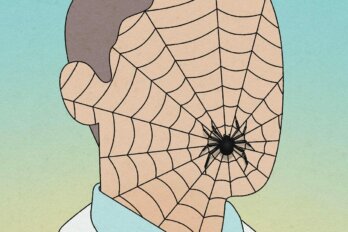One Friday evening, around eighty members of a quiet retirement community in Guelph, Ontario, gathered to hear a lecture. Often each week’s presenters catered to the audience on subjects of interest to the elderly, such as health or nutrition. On this night, however, the residents would be getting a different take. Given the location and the audience, this evening’s topic was in some ways insensitive but in others eminently practical: Who better, after all, to learn about the uses for a dead body?
The retirees sat around tables customarily used for card games as a visitor from the University of Guelph declaimed the virtues of donating one’s body to science. Paul and Irma Webb listened attentively but left the evening not entirely convinced. “We didn’t think very much of it at the time,” Paul says.
But over the next year, the idea gradually grew on the ever-practical Irma that to donate would be a fitting end to a lifetime of service: both she and her husband were once social workers. Paul decided to join her. It made sense, and after all, they had done nearly everything together for more than sixty years, from Regina to Hong Kong.
They finally set to work last fall. The paperwork wasn’t too complex, but complicated enough that life got in the way. They needed to get signatures from the executors of their wills and they had to discuss it with their children. It was Christmas before they knew it. “In January I told Irma, ‘We’re in our eighties—if we’re really serious about this, we need to finish it up,’” Paul says.
As it turned out, they finished just in time.
In Canada, thousands of people every year donate their bodies to eager universities that use them for research or medical training. Each province and territory has its own legislation, but the basics are the same: you can consent in advance, or your family can do it for you following your death. When you donate your body, every piece goes to education and scientific study, including your organs. And if you don’t want anything to go to waste, it’s additionally possible to include your eyes for corneal transplants.
If you’re planning on donating your body, or you’re related to a person who is, you may end up speaking to someone like Premila Sathasivam, the head of the body donation program at the University of Guelph. Talkative, with a warm smile and a disarming laugh, Sathasivam sets you at ease immediately—which is good, as the conversation you’ll be having with her is likely an uncomfortable one. She keeps her phone on all the time, ready to field calls from the recently bereaved and those with loved ones near their end. Often, body donation is a wish articulated from the deathbed. In these situations, Sathasivam says, “The timing is very crucial.”
Although it varies from school to school, there is an approximately seventy-two-hour window in which the body must be moved from the hospital to an embalming facility before putrefaction sets in. Thus begins a race against time to save a dead body. Medical histories are evaluated; death certificates are signed; transport is arranged. But some don’t make it. Despite the enthusiasm of the donor and their family, there are many reasons a body can be rejected. If you’re taller than six-foot-two or heavier than 250 pounds, for example, you probably won’t fit into storage. And if you succumbed to a contagious illness your body will be a vector for disease. If you died suspiciously and an autopsy was conducted, well, you can’t un-carve a pumpkin.
At anatomy schools across the country, there are application forms online you can print off and fill out. Most also feature helpful FAQs for those considering donation. “Are all the separate parts of my body somehow ‘reassembled’ together, and buried or cremated separately from the other bodies (or body parts) that were given to science?” one asks. Answer: The body parts are collected and each body is cremated separately. Universities discourage people from simply bequeathing in your will; in many cases, you’ve already been buried or cremated by the time your will is read. Sathasivam tells prospective donors to have frank conversations with their families about their wishes. Unfortunately, since this is a discussion best had in person, the timing is sometimes difficult to manage. “I keep telling them, they really need to have Christmas dinner before they talk about body donation,” Sathasivam says.
The exact embalming process depends on where you end up. In general, bodies are treated in a well-ventilated area with a variety of chemicals, including formaldehyde and phenol, which give off an astringent smell that lingers at the back of the throat. First, the body is shaved, washed, and disinfected. The technician cuts a major artery to drain the blood and replaces it with embalming liquid, either gravity-fed or pumped into the vascular system. The body then marinates for months so the fluid can permeate the flesh and turn the tissue stiff and grey. (An alternative method, inspired by wet-cured ham, has recently become popular as it better preserves the body’s texture.) When the cadaver is ready for dissection, it doesn’t look lifelike, but it will last a long time. Though funeral homes regularly embalm bodies to prepare them for visitation, their process is cosmetic and typically lasts only a few days or weeks before the body starts to decompose. Cadavers prepared for study, on the other hand, can be used for years if cared for properly. The University of Guelph still has pieces of donors from 2008.
Space is one of the most practical considerations. In her laboratory-turned-office—where the door opens onto a hand-washing station—Sathasivam flips through a catalogue with pictures of chrome dollies and appliances being wheeled around by scrub-clad models. Guelph is looking to expand its cold-storage facility. From individual refrigeration units to large, walk-in rooms, arranging, storing, and stacking bodies is an almost Tetris-like challenge, and each has benefits and drawbacks. Refrigerating a whole room, for example, is cost-effective but chemicals from the embalmed corpses build up in the sealed chamber and pose a danger to lab technicians. Tall units with extensive shelving require a hydraulic lift to get those hard-to-reach ones at the top.
Although the basic components of an anatomy lesson have not changed significantly—a group of students and an instructor around a cadaver—the method of procurement is quite different today. The Ancient Greek physician Herophilus, the first person to systematically dissect humans, was only allowed to practise on condemned criminals. In fifteenth-century Italy, as the study of human anatomy flowered again, universities offered free funerals in exchange for bodies, but demand eventually grew to the extent that students would try to ransack processions as they made their way to the graveyard. Four centuries later, in Edinburgh, William Burke and William Hare gained fame for smothering at least sixteen people and selling their bodies to the local medical school. At the same time, “resurrection men” stalked the cemeteries, exhuming bodies. The UK countered this wave of murder and grave robbing by passing a law that released the unclaimed bodies of the poor, incarcerated, and insane for dissection. People eventually got upset about that, too.
Today, schools in North America operate mostly via consensual donation. While computer-based educational tools are getting more sophisticated, universities still rely on a steady supply of corpses to teach a wide variety of prospective professions with an interest in your insides, including kinesiologists, dentists, and surgeons. The University of Guelph is working on a way to bring together the future and the past: as part of its outreach efforts, it has created a series of informative videos for those studying health-related disciplines but who don’t have access to cadavers. Sathasivam plays one for me in her office. It shows a body that has been bisected—that is, cut in half—that is being used like a dummy to demonstrate first-aid techniques. As a paramedic tilts the head back and lifts the chin, you can see the tongue move away from the airway, which would allow a living, non-bisected person to breathe. It’s an undeniably vivid illustration of how the technique works, and how crucial it is to see the real thing.
We walk down to the fluorescent-lit labs, ventilators thrumming overhead as they pump out the toxic smell of embalming fluid. Down the hall, groups of students are clustered around bodies with chest cavities cut open, exposing clay-textured organs and entrails. The students work methodically: it takes months to completely dissect a cadaver. The quiet, studious process of dissection is surprisingly meditative, and I lean in to see what is going on in each body until I see two students peeling away beads of white fat from a choked artery. Apparently my reaction is common; cutting through fat frequently causes students to gag, one of the reasons students and teachers generally prefer thinner cadavers.
On the inside, every body has its quirks, from unusual vasculature to a different number of ribs. A large wall hanging in the laboratory depicts a simplified body with smooth lines and clearly labeled organs, but there’s nothing quite like the real thing: what’s under the knife rarely looks the same as it does in the textbook, where illustrations still dominate. While idiosyncrasies give each cadaver a personality, who the person was in life is kept a secret. Bodies are typically assigned a number and at no point during the dissection are their names revealed.
As you reach the end of your second life, your body undergoes a more conventional ritual: cremation. Guelph, as with most universities, keeps track of your parts—so, even if you spend a few years divided, you can be reasonably sure that your urn will ultimately contain all of you and nobody else. Some schools have their own plot where ashes are interred, though they send them to the next-of-kin if requested. The annual memorial services are frequently well attended; because of the short time frame in which a body has to be moved and embalmed, there is rarely time for friends and family to hold a conventional funeral. The services are non-denominational, with most religions open to body donation. (Some interpretations of Islam and Judaism prohibit it.) But in a way, body donation is the triumph of a secular humanist’s vision of the afterlife: people do not go to a better place, but to a more useful place.
It was Sathasivam who gave the lecture to Paul and Irma Webb at the Guelph retirement community two and a half years ago, and who gave me the couple’s contact information with their permission. I wanted to speak to someone who was already planning to donate their body. Sathasivam suggested I try the couple a few days later, because they were about to leave for a short vacation, and there was, after all, no rush.
Irma died suddenly of a brain hemorrhage the day that I followed up. There were no signs she was in ill health; they had no reason to think that their sixtieth wedding anniversary would also be their last. Oblivious to the invisible bleeding, Paul kept talking to his wife, but Irma never replied. She was rushed to hospital but it was too late. Sathasivam arrived shortly thereafter to help make the arrangements and Irma’s body was taken away.
Paul’s voice still trembled when I spoke to him on the phone two weeks later. He says he takes solace in the fact that he was able to fulfill her wishes, and that they managed to file their paperwork about ten days before Irma died. “It was totally unexpected,” he says. “But she had made the decision and we went ahead with it.”
In many ways, body donation is a clinical process—fast, efficient, and respectful—but it also arises during one of life’s most emotional phases. While there are many complexities to the affair—transport, embalmment, dissection, cremation—the most complicated and messiest part of donating your body to science is not what happens to you. It’s what happens to those you leave behind.





